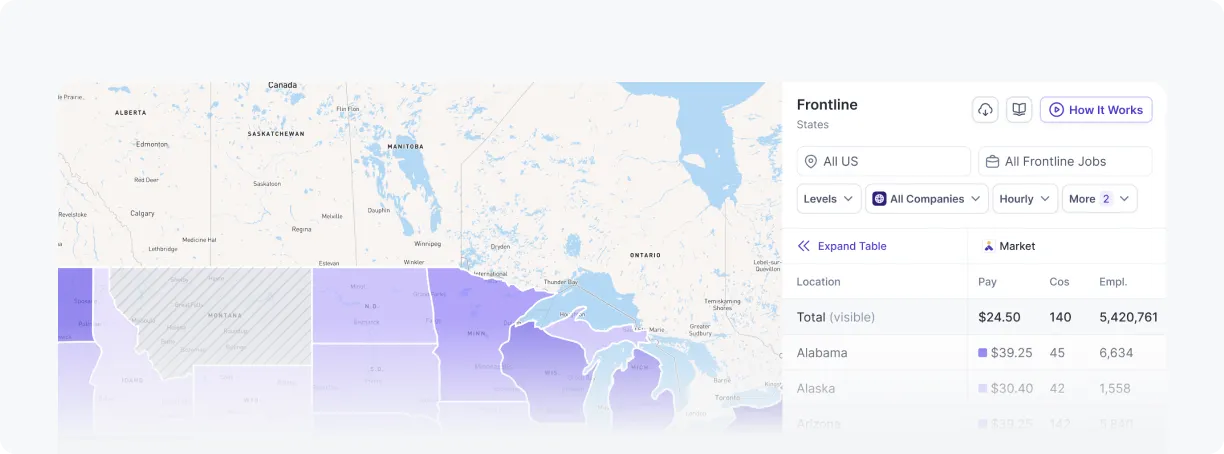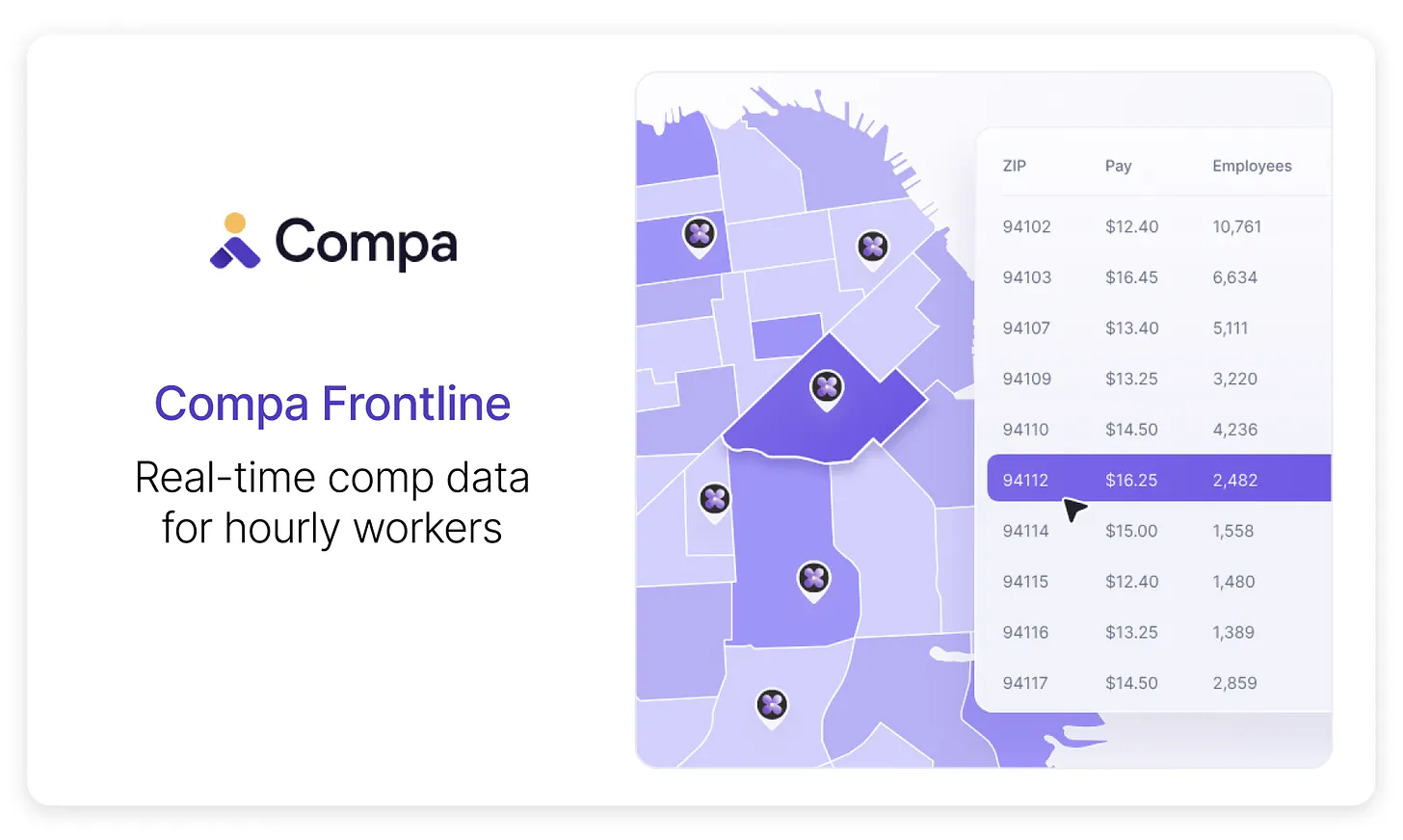And how our newest product at Compa aims to solve it
Key topics
We announced a new product last week: Compa Frontline, a new way to benchmark hourly worker pay with real-time data down to the zip code.
I rarely paid attention to hourly worker (“frontline”) issues when I was in comp — it wasn’t very relevant in tech, and seemed uninteresting.
I had no idea.
Over the past year I have learned how overwhelmingly big the frontline comp problem is, driven by three fundamental challenges:
- City block-level competition
- Highly-fungible talent
- Rapid market changes
25 cents becomes $50 million
Frontline workers are typically paid less than knowledge workers, but the companies are bigger by headcount, and there are way more people scattered across the world in storefronts, distribution centers, field sites, and manufacturing facilities.
As a result, seemingly small comp decisions drive millions in spend — it’s a different type of complexity.
Consider a 10,000-person tech company versus a 100,000-person retailer.
- If tech market salaries grow $1,000 per person, your annual costs increase by $10 million
- If frontline worker wages grow $0.25/hour per person, your annual costs increase by $52 million
Getting compensation correct down to 25 cents, distributed across 100,000 people, is the impossible frontline comp challenge.
And it starts with nailing location.

Location, location, location
Location drives everything in frontline talent markets.
- In Las Vegas, Nevada, a coffee shop on the Strip pays far more than a coffee shop less than one mile away
- In Bozeman, Montana, the spiking real estate market is fueling a spiral in frontline worker shortages and rapid pay increases as new retailers scramble to establish in the area. Meanwhile, 20 miles away, nothing has changed
In knowledge worker comp we think about talent markets as broad metropolitan areas, like the SF Bay Area, and might have 3 or 4 geo tiers in the U.S.
In frontline comp, talent markets can vary down to the zip code, if not city block, and a company might define 200+ distinct markets in the U.S. alone.
Highly-fungible talent
The frontline workforce is highly fungible, meaning:
- The talent market is massive with low switching costs
- Job matching must flex between specific and broad
Unlike in tech where a small number of people know how to, say, engineer a fiberoptic network, low-skilled workers can easily switch between different roles and industries. The same person could be a cashier, a barista, or a concierge — all in the same year.
This means your peer group is as much a function of location as it is the company’s specific domain, and it constantly changes.
Even when you get your competition defined, job matching is still a nightmare.
Consider a real example from two nearly identical retailers:
- The first company differentiates pay between cashiers who scan items over a counter and cashiers who scan items with a scan gun
- The second company hires for a single job where the same person checks out customers, sells electronics, and unloads the truck in the back
How could a survey possibly match jobs accurately between these two companies?
Rapid change: competition, legislation, and seasonality
Talent markets change constantly and non-uniformly.
I recently asked the head of comp at a major retailer who their compensation peer group is. She said:
Step outside one of our stores and look across the parking lot at every other store you see in the strip mall — that’s our peer group.
When a new retailer moves in, or a new distribution center opens, or when a manufacturing plant closes, that talent market changes over night, while others simultaneously move the opposite direction.
Add to that minimum wage laws and pay transparency laws, which have exploded across the world in the past few years, varying by state, county, and city, and change year-to-year.
And of course seasonality drives changes in pay, whether it’s the holiday rush in retail or the summertime vacationers in hospitality.
A new way to benchmark frontline comp

I became excited about the frontline comp problem about a year ago.
One of our customers who spans the tech and retail worlds began partnering with us on the tech side, but urged us to learn more about the retail side and its accompanying comp challenges.
As we dug in, I observed that:
(a) traditional surveys terribly underserve this market, and
(b) real-time market data has the potential to completely transform frontline comp strategy with better data.
So we set about developing a new benchmarking solution, and recruited a group of visionary comp teams at the world’s best retailers to join us as launch partners.
The result is our new product, Compa Frontline, and it’s now live with many of the world’s best retailers.
It aims to solve each of the three big challenges:
- A map-based benchmarking experience with zip code-level market insights
- Flexible matching based on job and level, but also tenure and skills to solve the coordination problem
- Software-delivered, validated, real-time data powered in a give-to-get model by the network of participating companies
Where this goes next
Last week’s launch of Compa Frontline represents a powerful new way for enterprise comp teams to compete in the massive, volatile frontline markets.
We are initially focused on serving the retail industry, alongside tech and life sciences companies with frontline worker populations, and will add more soon.
We will also continue expanding the platform capabilities as more companies enter the network, tackling complicated and unique pay elements like shift differentials and bringing in more market context.
Want to see it live? DM me on LinkedIn and I’ll show you how it works.
Our mission at Compa is to make compensation fair and competitive for everyone by powering smarter pay decisions. We’re now applying that mission to the hardest problem in comp: the frontline.

.svg)

.webp)
.webp)
.webp)
